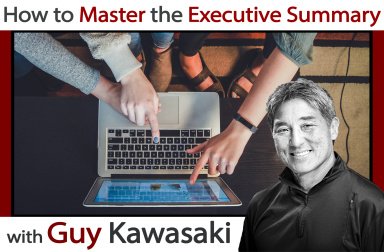
Last version published: 17/04/2020 12:59
Publication number: ELQ-71063-2
View all versions & Certificate

How to Master the Executive Summary
A guide by Guy Kawasaki with tips on how to master the art of the executive summary.
Introduction
Several people have asked me for a blog entry about executive summaries. My colleague at Garage, Bill Reichert, wrote this explanation, and it’s as good as it gets.
Writing a Compelling Executive Summary
By now, you’ve probably already read several articles, web pages—even books—about writing the perfect executive summary. Most of them offer a wealth of well-intended suggestions about all the stuff you need to include in the executive summary. They provide a helpful list of the forty-two critical items you should cover—any entrepreneur worth his or her salt should be able to address these points in less than 100 pages—and then they tell you to be concise.
Most guides to writing an executive summary miss the key point: The job of the executive summary is to sell, not to describe.
The executive summary is often your initial face to a potential investor, so it is critically important that you create the right first impression. Contrary to the advice in articles on the topic, you do not need to explain the entire business plan in 250 words. You need to convey its essence, and its energy. You have about 30 seconds to grab an investor’s interest. You want to be clear and compelling.
Forget what everyone else has been telling you. Here are the key components that should be part of your executive summary:
- Step n°1 |
The Grab
You should lead with the most compelling statement of why you have a really big idea. This sentence (or two) sets the tone for the rest of the executive summary. Usually, this is a concise statement of the unique solution you have developed to a big problem. It should be direct and specific, not abstract and conceptual. If you can drop some impressive names in the first paragraph you should—world-class advisors, companies you are already working with, a brand name founding investor. Don’t expect an investor to discover that you have two Nobel laureates on your advisory board six paragraphs later. He or she may never get that far. - Step n°2 |
The Problem
You need to make it clear that there is a big, important problem (current or emerging) that you are going to solve. In this context you are establishing your Value Proposition—there is enormous pain out there, and you are going to increase revenues, reduce costs, increase speed, expand reach, eliminate inefficiency, increase effectiveness, whatever. Don’t confuse your statement of the problem with the size of the opportunity (see below). - Step n°3 |
The Solution
What specifically are you offering to whom? Software, hardware, service, combination? Use commonly used terms to state concretely what you have, or what you do, that solves the problem you’ve identified. Avoid acronyms and don’t try to use this opportunity to create and trademark a bunch of terms that won’t mean anything to most people. You might need to clarify where you fit in the value chain or distribution channels—who do you work with in the ecosystem of your sector, and why will they be eager to work with you. If you have customers and revenues, make it clear. If not, tell the investor when you will.

